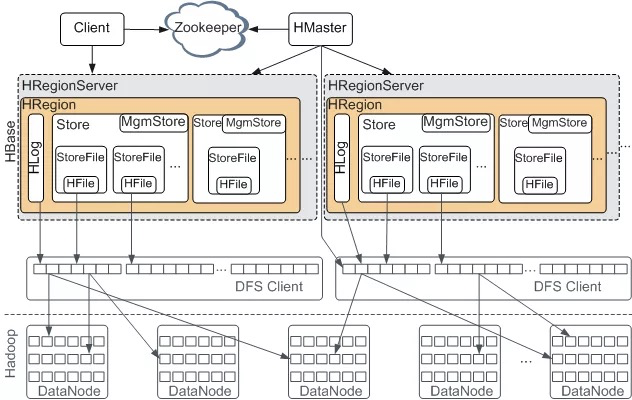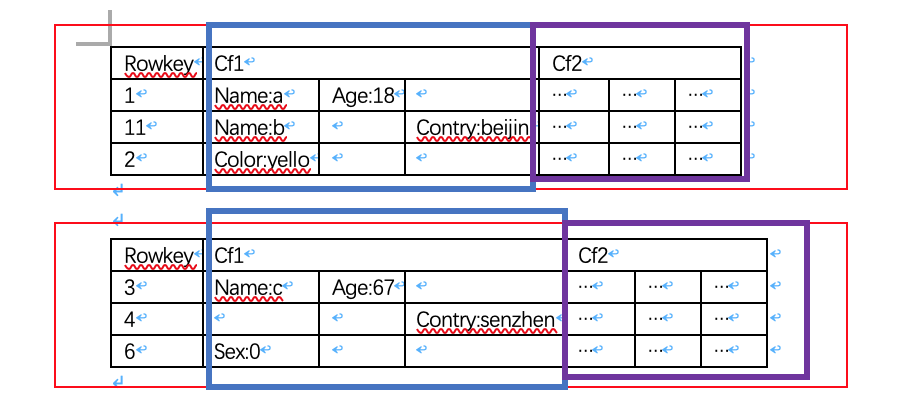HBase是一个分布式,可扩展,多版本,大数据存储的非关系型数据库。
简介
首先HBase是一个数据库,和MySQL类似,为了存储数据而存在,不过它适用的场景是大数据领域,当MySQL在单台机器或者经过分库分表之后都还是难以满足需求的情况,就可以考虑使用HBase了。
针对它的特点:
- 分布式:它依赖HDFS(hadoop分布式文件系统),进行分布式存储
- 可扩展:HBase的存储可以通过添加机器,添加RegionServer来进行扩展
- 多版本:一条数据被更新多次后依旧可以查询到之前的版本,它会保留多个版本
- 非关系型数据库:关系型数据库就是二维表,非关系型就是非二维表结构,在HBase中都是kv键值对存储
特点
- 可扩展
- 严格一致性读写,在cap理论中保证了CP
- 自动或者可配置的表切片
- regionServer之间故障转移
- 块缓存(BlockCache)和布隆过滤器加快查询效率
- wal预写日志,几乎所有的数据库都会采用wal技术
- 支持通过Hadoop指标子系统将指标导出到文件或Ganglia;或者jmx
缺点
- 单一rowkey导致多维查询效率低下
- 不直接支持SQL
- 仅支持行级事务
当然,这些都可以被其他中间件解决,比如phoenix
架构

hbase是一个分布式的系统,基于master/slaver架构,并且依赖zookeeper。屏蔽底层依赖的HDFS,也就剩下三个组件:HMaster,RegionServer,zookeeper。它们的作用分别如下:
HMaste
Hmaster是master,通常运行在有namenode的机器上,功能:
- 处理用户的各种管理请求:建表,修改表,删除表,权限操作,切分表,合并分片,compactions
- 管理所有的RS,包括Region的负载均衡,RS的宕机恢复,Region的迁移
- 清理过期日志以及文件,每隔一段时间会检查hdfs上的hlog,hfile是否过期,过期则删除
HMaster提供的接口:
- Table (createTable, modifyTable, removeTable, enable, disable)
- ColumnFamily (addColumn, modifyColumn, removeColumn)
- Region (move, assign, unassign)
可以认为是ddl
HMaster是一个领导整个集群的作用,它管理RegionServer,管理表结构信息,表的元数据信息,因此当它down掉后,会损失部分功能。由此可见在设计上需要避免单点故障,因此在上图中虽然只有一个HMaster,但实际上会配置多个HMaster,在同一时刻只有一个HMaster是活跃(active)状态,其它的HMaster只是备胎(standby),当zk发现现有的HMaster挂掉了之后会从备胎中选出一个作为active。
那么如何保证active和standby之间的数据一致性呢:热备
HRegionServer
HRegionServer 是slaver,通常放在datanode的机器上,主要响应用户的IO请求,管理一些Region(Region就是一张表的横向切片)。RegionServer是真正的对数据操作的执行者,包括增删改查;还有合并HFile,当一个Region太大的时候还会切分。
放在datanode上是因为可以更好的让数据本地化,也就是这个RegionServer管理的Region就在此台机器上。
对外提供的接口
- Data (get, put, delete, next, etc)
- Region (splitRegion, compactRegion, etc)
zookeeper
功能:
- 实现master的高可用:为了避免单点故障,启动多个master,但是只有一个master是active;当zk观测到master宕机时,会选举出一个master
- 管理元数据:hbase:meta的所在RegionServer的位置等
- 参与RegionServer宕机恢复,存储各种中间过程状态,在比如切分过程中,必定存在各种状态,zk就是用来让RegionServer和HMaster通信
- 实现分布式表锁
客户端
通过客户端向hbase发送指令。
可以看见在HMater和Regionserver上做了职责切分,HMater总览全局,RegionServer是执行者。在正常情况下HMaster的压力是比较小的。整体架构如上,数据真实存在各个RegionServer管理的Region上。
数据模型
在MySQL上,分为database,table,row,col。这是MySQL数据的逻辑结构,在hbase上逻辑结构如下:
在hbase中,分为命名空间(namespace),表(table),行(row),列簇(column family),列(column Qualifier),cell,timestamp
- namespace:表的逻辑分组,用来区分表在哪一个命名空间,类似MySQL中的database
- table:属于一个namespace,一个table由很多行(row)组成,类似MySQL中的table
- row:一行由多个列的值组成,每一行有一个唯一的rowkey,按照字典序升序排列
- column family(列簇):每一个表有多个列簇,一个列簇可以包含多个列,在创建表时需要指定,因为在表结构中会定义列簇而不会定义列;
- column Qualifier:每一个列都属于一个列簇,由“列簇:列标识”标识,创建表的时候不指定列标识
- cell,一个单元格,由rowkey,(column family:column),timestamp,value确定,标识一个版本;时间戳表示写入数据时在RegionServer上的时间,在将数据放入单元格时也可以指定其他时间戳值。
- timestamp,时间戳,用来确定一个值的版本,一个cell可有由多个版本,但是只有最新的有效
- version:一个单元格可以有多个版本,并且按照时间戳降序排序;可以设置版本数
- 排序:HBase的所有数据模型操作均按排序顺序返回数据。首先是按行,然后是ColumnFamily,然后是column qualifier,最后是时间戳(按相反顺序排序,因此首先返回最新记录)。
以一张图举例:
这是一张表,有两个横向切分,红色部分是两个Region,在Region中有两个Region分别用蓝色和紫色指出,每一个都是一个Store。在一个列簇中可以有多个不同的列。
例子:1
2
3
4
5
6
7
8
9
10
11
12
13
14
15# 创建表名为test,包含一个列簇cf1
# 没有指定命名空间,默认为default
create 'test','cf1'
# 存入rowkey为1,列为cf1:name,值为liunn,当前时间错得数据
put 'test','rowkey1','cf1:name','liunn'
put 'test','rowkey1','cf1:age','18'
put 'test','rowkey2','cf1:addr','china'
put 'test','rowkey2','cf1:color','yello'
# 查看test存储的所有的数据,2行,一个列簇,4列,4个单元格
ROW COLUMN+CELL
rowkey1 column=cf1:age, timestamp=1572506321932, value=18
rowkey1 column=cf1:name, timestamp=1572506338839, value=liunn
rowkey2 column=cf1:addr, timestamp=1572507573798, value=china
rowkey2 column=cf1:color, timestamp=1572507585208, value=yello
2 row(s)
可以看见数据并非像mysql一样按行存储,而是按列存储,每一个单元格就是一个key-value对
存储
表的数据存储在hdfs上,也就是datanode上,它的物理结构如下
- Region:表的横向切分,当表过大的时候就会分片,分为多个region。比如一张表的rowkey是1–100,那么它可以1–50一个region,50-100一个region。
- store,一个Store是属于一个region,在一个Region中按照列簇切分为多个store。比如一张表有两个列簇,那么每个Region都有两个store。store又分为内存和磁盘。
- memStore:内存中的数据,为了加快写的速度而存在
- storeFile:在store内部,包含多个storeFile,sotreFile是由memStore一次flush产生的,每一次flush都会产生一个storeFile
- Hlog:wal中的预写日志
- HFile:数据格式
如下图所示:
使用
- 安装
- 启动
start-dfs.sh start-hbase.sh - 使用shell操作
shell命令
可以参考 https://blog.csdn.net/vbirdbest/article/details/88236575
以hbase shell启动shell
1 | hbase(main):013:0> help |
常用命令
| 命名 | 描述 | 语法 |
|---|---|---|
| help ‘命名名’ | 查看命令的使用描述 | help ‘命令名’ |
| whoami | 我是谁 | whoami |
| version | 返回hbase版本信息 | version |
| status | 返回hbase集群的状态信息 | status |
| table_help | 查看如何操作表 | table_help |
| create | 创建表 | create ‘表名’, ‘列族名1’, ‘列族名2’, ‘列族名N’ |
| alter | 修改列族 | 添加一个列族:alter ‘表名’, ‘列族名’ ;删除列族:alter ‘表名’, {NAME=> ‘列族名’, METHOD=> ‘delete’} |
| describe | 显示表相关的详细信息 | describe ‘表名’ |
| list | 列出hbase中存在的所有表 | list |
| exists | 测试表是否存在 | exists ‘表名’ |
| put | 添加或修改的表的值 | put ‘表名’, ‘行键’, ‘列族名:列名’, ‘列值’ |
| append | 在一个单元格内追加数据 | append ‘talbeName’,’rowkey’,’cf:col’,’val’ |
| scan | 通过对表的扫描来获取对用的值 | scan ‘表名’ ; 扫描某个列族: scan ‘表名’, {COLUMN=>‘列族名’} ;扫描某个列族的某个列: scan ‘表名’, {COLUMN=>‘列族名:列名’} ;查询同一个列族的多个列: scan ‘表名’, {COLUMNS => [ ‘列族名1:列名1’, ‘列族名1:列名2’, …]} |
| get | 获取行或单元(cell)的值 | get ‘表名’, ‘行键’ ;get ‘表名’, ‘行键’, ‘列族名’ |
| count | 统计表中行的数量 | count ‘表名’ |
| incr | 增加指定表行或列的值 | incr ‘表名’, ‘行键’, ‘列族:列名’, 步长值 |
| get_counter | 获取计数器 | get_counter ‘表名’, ‘行键’, ‘列族:列名’ |
| delete | 删除指定对象的值(可以为表,行,列对应的值,另外也可以指定时间戳的值) | 删除列族的某个列: delete ‘表名’, ‘行键’, ‘列族名:列名’ |
| deleteall | 删除指定行的所有元素值 | deleteall ‘表名’, ‘行键’ |
| truncate | 重新创建指定表 | truncate ‘表名’ |
| enable | 使表有效 | enable ‘表名’ |
| is_enabled | 是否启用 | is_enabled ‘表名’ |
| disable | 使表无效 | disable ‘表名’ |
| is_disabled | 是否无效 | is_disabled ‘表名’ |
| drop | 删除表 | drop的表必须是disable的 ,disable ‘表名’ ,drop ‘表名’ |
| clone_snapshot | 从snapshot中克隆一个新表 | clone_snapshot ‘snapshotName’, ‘tableName’ |
| snapshot | 创建一个快照 | snapshot ‘namespace:sourceTable’, ‘snapshotName’, {SKIP_FLUSH => true} |
| restore_snapshot | 从快照中恢复,快照点之后的数据被删除 | restore_snapshot ‘snapshotName’ |
| list_snapshots, list_table_snapshots | 列出快照 | |
| delete_all_snapshot, delete_snapshot, delete_table_snapshots | 删除快照 | |
| shutdown | 关闭hbase集群(与exit不同) | |
| tools | 列出hbase所支持的工具 | |
| exit | 退出hbase shell |
这些命令都可以通过help ‘xxx’查询,并且都是Ruby格式的脚本。
脚本使用
- 开启集群
start-hbase.sh - 关闭集群
stop-hbase.sh - 开启/关闭所有rs,zk
hbase-daemons.sh start/stop regionserver/zookeeper - 开启/关闭单个rs,zk
hbase-daemon.sh start/stop regionserver/zookeeper - 开启/关闭master
hbase-daemon.sh start/stop master,是否成为active取决于当前是否存在active master
hbase脚本参数
- hbase shell
- hbase hbck,运维时候用,检查集群数据一致性状态,执行是直接调用org.apache.hadoop.hbase.util.HBaseFsck中的main函数
- hbase hlog,log分析工具,其执行是直接调用org.apache.hadoop.hbase.regionserver.wal.HLogPrettyPrinter中的main函数
- hbase hfile, hfile分析工具,其执行是直接调用org.apache.hadoop.hbase.io.hfile.HFile中的main函数
- hbase zkcli,查看/管理ZK的shell工具
- hbase classpath,打印classpath
- hbase version,打印版本
java api
java api就是将shell中的命令封装成了java对象。
通常在操作之前先获取配置,然后获取连接
1 | private static Configuration conf; |
操作表
对表的操作,ddl,需要类HBaseAdmin1
2
3
4
5
6
7
8
9
10
11
12
13
14
15
16
17
18
19
20
21
22HBaseAdmin admin= (HBaseAdmin) conn.getAdmin();
// HTableDescriptor对应对表信息的描述
//HColumnDescriptor对应对列簇的描述
/**
* 预分区创建表
* @param tableName
* @param splitsKeys
* @param columnFamily
* @throws IOException
*/
public static void createTablePreSplit(String tableName,byte[][] splitsKeys,String... columnFamily) throws IOException {
HBaseAdmin admin= (HBaseAdmin) conn.getAdmin();
HTableDescriptor descriptor=new HTableDescriptor(TableName.valueOf(tableName));
//添加列簇
for(String cf:columnFamily){
descriptor.addFamily(new HColumnDescriptor(cf));
}
admin.createTable(descriptor,splitsKeys);
logger.info("table: {} create success",tableName);;
}
操作数据
对表中的数据的操作,dml,需要类HTable;1
HTable table= (HTable) conn.getTable(TableName.valueOf(tableName));
对于put操作,先用rowkey构造put对象,然后添加cf,col,val;1
2
3Put put=new Put(rowkey.getBytes());
put.addColumn(cf.getBytes(),col.getBytes(),val.getBytes());
table.put(put);
对于Scan操作,先构造Scan对象,然后添加限定条件;
获得的结果是一个集合ResultScanner,每一个集合的元素Result(代表一行)又包含多个cell1
2
3
4
5
6
7
8
9
10
11
12
13
14
15
16
17
18
19
20
21public static void scan(String tableName,String cf,String col) throws IOException {
HTable table= (HTable) conn.getTable(TableName.valueOf(tableName));
Scan scan=new Scan();
if(cf!=null) {
scan.addFamily(cf.getBytes());
}
if (col!=null){
scan.addColumn(cf.getBytes(),col.getBytes());
}
ResultScanner scanner = table.getScanner(scan);
for (Result result:scanner){
Cell[] cells = result.rawCells();
for (Cell cell:cells){
System.out.println(Bytes.toString(CellUtil.cloneFamily(cell)));
System.out.println(Bytes.toString(CellUtil.cloneQualifier(cell)));
System.out.println(Bytes.toString(CellUtil.cloneValue(cell)));
System.out.println(Bytes.toString(CellUtil.cloneRow(cell)));
}
}
}
对于get操作,用rowkey构造get对象,设置条件,得到结果Result1
2
3
4
5
6
7
8
9
10
11
12
13
14
15
16
17
18
19
20public static void get(String tableName,String rowkey,String cf,String col) throws IOException {
HTable table= (HTable) conn.getTable(TableName.valueOf(tableName));
Get get=new Get(Bytes.toBytes(rowkey));
if (cf!=null){
get.addFamily(Bytes.toBytes(cf));
}
if (col!=null){
get.addColumn(cf.getBytes(),col.getBytes());
}
get.setMaxVersions();
Result result = table.get(get);
Cell[] cells=result.rawCells();
System.out.println(cells.length);
for (Cell cell:cells){
System.out.println(Bytes.toString(CellUtil.cloneFamily(cell)));
System.out.println(Bytes.toString(CellUtil.cloneQualifier(cell)));
System.out.println(Bytes.toString(CellUtil.cloneValue(cell)));
System.out.println(Bytes.toString(CellUtil.cloneRow(cell)));
}
}
delete操作1
2
3
4
5
6
7public static void delete(String tableName,String cf,String col,String rowkey) throws IOException {
HTable table= (HTable) conn.getTable(TableName.valueOf(tableName));
Delete delete=new Delete(rowkey.getBytes());
delete.addColumn(cf.getBytes(),col.getBytes());
table.delete(delete);
}
这就是hbase的基础知识了,了解了基础架构就可以搭建环境,并且开始创建表,增删改查。
